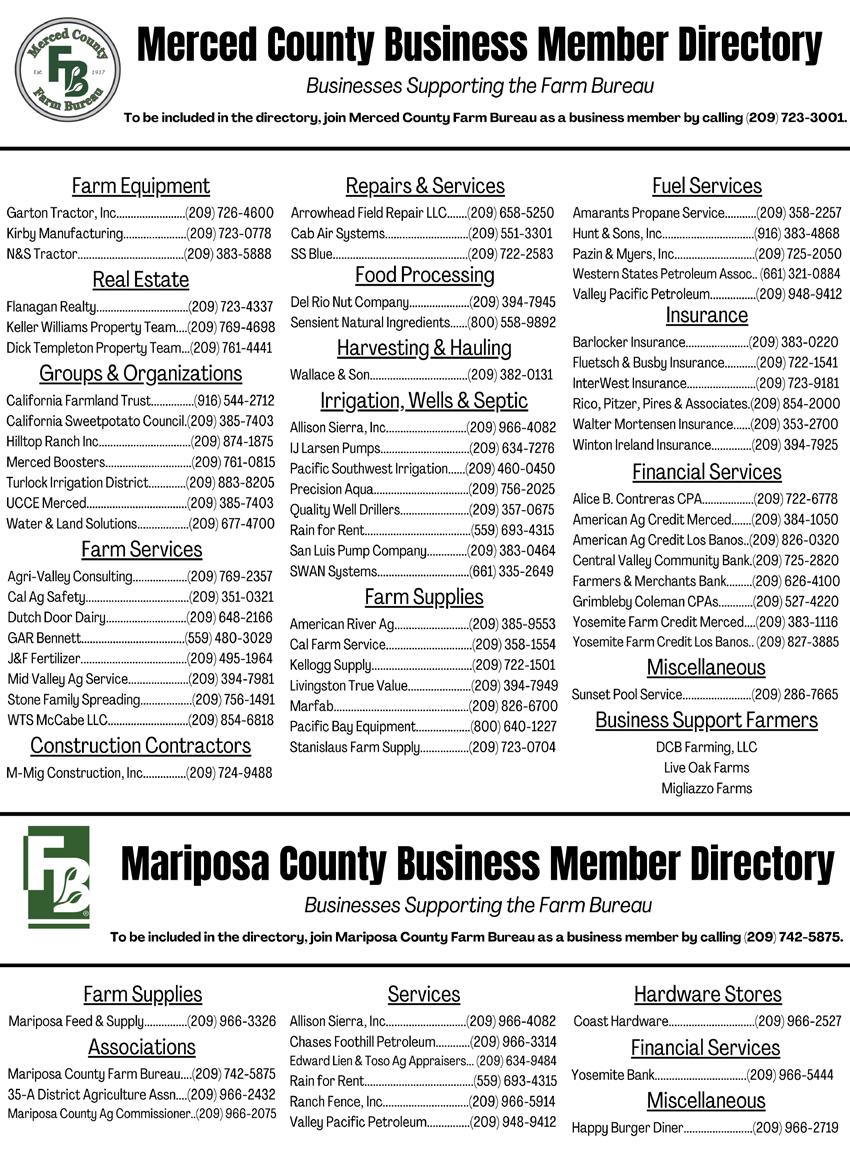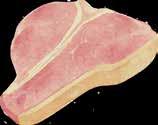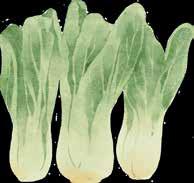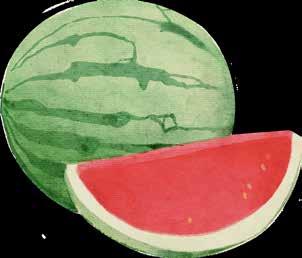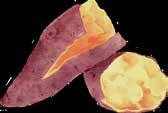

Seven questions for the new head of the California Farm Bureau
By: Chloe Lovejoy and Brad Hooker, Agripulse
The California Farm Bureau elected Shannon Douglass to a two-year term as its president in December. She previously served as CAFB vice president and is the first woman to head the organization.
She also runs Douglass Ranch in Orland with her husband, Kelly.
Agri-Pulse asked about her first six months as president and what advocacy priorities will look like for CAFB under her leadership.
She took over the state’s largest general farm organization in a challenging financial situation. For 2022, the group reported a deficit of about $4 million on revenues of just over $11 million, with total assets of $76.7 million.
The conversation has been edited for brevity and clarity.
Describe how your career path and ranching operation led you to Farm Bureau presidency.
I started getting involved in the Farm Bureau in college. I went to Chico State and was involved in the Butte County Young Farmers and Ranchers program through the Butte County Farm Bureau. I was able to get involved in a campaign fighting against a local measure. … I accidentally ended up doing some media interviews … but also got to be part of their campaign walks, where we would go door-to-door and talk to people at their homes. By many accounts it was an uphill battle that we probably should have lost, and the message should have passed just by the community sentiment and the type of press regarding GMOs at the time. But by taking action and by working on that campaign,
we could make a difference— and I got to see the impact. When I settled in Glenn County with my husband, we were … part of the group that started the Young Farmers [&] Ranchers program in Glenn County. That was just such a great way to be connected with other people who were in similar stages of life as us.
I ended up the chair of our … program, then I went to serve on our state committee for a number of years. Eventually I was the chairman…. About seven years ago, when there was the opportunity to run for statewide office, I thought, I think it's the right time and I think I could help and … serve our members well in this role.
I served for six years as the first vice president at California Farm Bureau and then in December
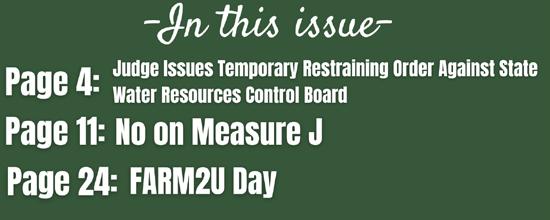
was elected the president …. My husband was born and raised on a dairy. Before we finished college, we started our farm enterprise on a very, very small scale. There were dairy heifers involved, initially replacement dairy heifers and then beef cattle. Today we are diversified farmers with a real combination of things. We have beef cattle, we have walnuts. We grow forage crops—primarily alfalfa, dairy silage, retail hay. We do specialty sunflower seeds or seed production, and then other commodities that come and go, just depending on the
See 'CAFB' Page 14
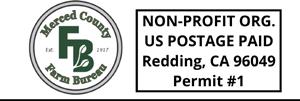

With the celebration of 4th of July, cookouts and endless fireworks also come the ramp up for the November election. I know I talk about this each election year, but I absolutely feel that the number of brochures and flyers we receive increases exponentially each cycle. We are watchful of the races as they develop, and our board is preparing for our routine candidate nights. This event provides the board the opportunity to hear from candidates in a debate setting. The entire event takes about 30 minutes for each and can be eye-opening to say the least. As an organization, MCFB does not take up the elections of the various cities or irrigation districts that fall within our jurisdiction. Although we do not get involved with those, we do engage and remain aware what is taking place within those races as they each have influence in what happens to our members.
This past month I was invited to speak at the Merced County Republican Committee Meeting. I am always happy to speak for various groups and provide an overview of what agriculture is facing.
It is never an uplifting conversation but hopefully one that people can walk away with a better understanding of what our farmers and ranchers experience. I should also note that for anyone reading, if the Merced County Democratic Committee ever asked me to speak, I’d be more than happy to do so.
Our office has been heavy at work on projects outside of the norm. Recently our Farmland Protection Fund (FPF) has stepped up in a several ways mainly in donations. The first was to our local Ag Crimes law enforcement teams in the purchase of equipment to help in their fight. Secondly, we’ve donated to Kings County Farm Bureau (KCFB) towards their SGMA Defense Fund. KCFB has filed a lawsuit against the State Water Board (SWB) for their action in placing the Tulare Lake Subbasin on probation under the rules of the Sustainable Groundwater Management Act (SGMA). They still have a long
way to go on this, but a bright spot has been the recent issuance of a temporary restraining order against the SWB. The restraining order will be in place until Tuesday, August 20, 2024 when the judge will consider a temporary injunction. Finally, FPF in partnership with several others, is in the near stages of submitting a grant proposal to EPA. Should it be granted, we hope to bring additional resources to the community, specifically aiding our dairy families. Lastly, I wanted to remind everyone of Measure J facing Sonoma County this November. Placed on the ballot by Direct Action Everywhere (DxE), the measure will force Confined Animal Facility Operations (CAFO) to close within 3

years. This includes dairies, poultry facilities, etc that fit the animal requirement. The Ag Commissioner will be tasked with the closures. In addition, the employees of these facilities would then be provided with new skills through job training put on by Sonoma County. The measure does not state where the money would come from for the job training. While DxE has stated this does not impact family farms, we find fault in that and feel that this fight could come to Merced County should they win in Sonoma. You can find more information at www.noonmeasurej.com. Donations can be made by mail or online and directions on how to do so can be found on the above mentioned website.


Ihope we are all enjoying the hot dog days of summer. The summer heat is fully upon us and I hope we are all finding a way to deal with it. I am sure we are all very busy on our own operations. Many of us are busy spraying, irrigating, or getting ready for or in the middle of harvest. Your local Farm Bureau has been busy as well, and just to keep things interesting we are in an election year like none other that I can remember. The California Supreme Court has ruled that the Taxpayer Protection Act is unconstitutional and was removed from our ballots. Our friends in Kings County have filed a lawsuit against the State Water Resources Control Board over SGMA.
On June 20th, the California Supreme Court ruled that, the Farm Bureau supported, Taxpayer Protection and Government Accountability Act violates the California Constitution. It is a shame that the California Supreme Court is influenced by the political whims of California’s Super-Majority and oneparty rule, led by a feckless governor, silenced the voice of the voters of this state by removing this proposition from our November ballots. Not to mention the 1.4 million fellow Californians that signed the petition to qualify this proposition for the November election. This, combined with the gross fiscal mismanagement
that turned a 100 billion surplus into a 70 billion deficit, with absolutely no logical explanation, gives our politicians one less speed bump to raising taxes. As of right now there is no plan on the next step, but we will not get the chance to voice our opinion on the TPA in November.
Our friends to the south in The Kings County Farm Bureau are leading the way in bringing accountability to the unelected bureaucrats at the State Water Resources Control Board. On May 15th the Kings County Farm Bureau along with two of its members filed a lawsuit in State Court against the State Water Resources Control Board. The lawsuit stems from the water board’s decision to place the Tulare basin on probation on April 16th. The filings claim that this designation “exceeds the waterboards jurisdiction and probationary designation is arbitrary, capricious, and lacking in evidentiary support.” In what we hope to be the first of many victories, a Superior Court Judge issued a temporary restraining order against the State Water Board on June 16th. As with all lawsuits they require a large amount of financial support to be successful, Your Farm Bureau Board has made the decision to support our neighbor’s cause. This is the first in what could be a litany
of judicial maneuvering and we felt that it would benefit our local agriculture community by getting on board and supporting this lawsuit. If anyone is willing to personally support Kings County please reach out to our local office, myself or Kings County Farm Bureau directly at (559) 584-3557.
Election Day is November 5th and approaching quickly. It is our responsibility as citizens and members of this community to educate ourselves. There will be many offices at the Local, State, and National level up for election. All these offices along with the ballot propositions and local measures will affect all of us and our way of life in some way. It is our civic duty to be an informed electorate and ask ourselves things like, has one party rule served us well in Sacramento? Have our local representatives
represented us well at the State and Federal levels? How will this Ballot proposition affect my lively hood? In the upcoming months your board of directors will get to hear from some of the candidates vying for local election. If your board chooses to make an endorsement we will publish it in a future issue of Farm News. Let’s all hope that the election results will be beneficial to our way of life. As we all get ready to begin or continue harvest be assured that your Local and State Farm Bureaus will continue to represent us in the best way possible. The fight never ends and there is nobody better to have on our side than your Farm Bureau. As always don’t ever hesitate to reach out to the office, myself, or any of your board members should you have any concerns or need assistance with anything.
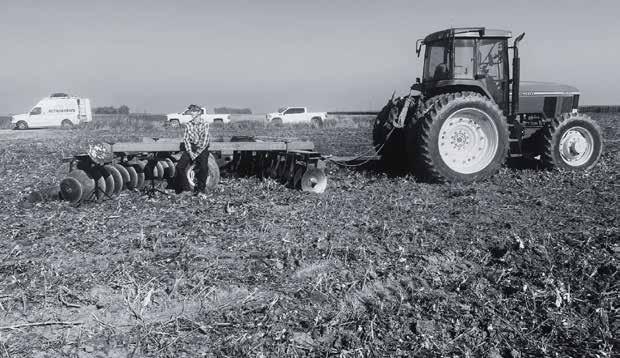


Judge Issues Temporary Restraining Order Against State Water Resources Control Board
By: Kings County Farm Bureau
Hanford, Calif. — On Monday, July 15, 2024, Kings County Superior Court Superior Judge Ciuffini issued a temporary restraining order (TRO) against the State Water Resources Control Board (SWRCB). Pending a hearing, the SWRCB and its agents, servants, partners, and employees, and all persons acting on its behalf are restrained and enjoined from enforcing SWRCB Resolution No. 2024-0012, “Designating the Tulare Lake Groundwater Subbasin as Probationary Under the SGMA.” The restraining order remains in effect until Tuesday, August 20, 2024, when the judge will consider issuing a temporary injunction.
The TRO means that growers in the subbasin are not required to meter or record groundwater pumping information until further notice.
Judge Ciuffini issued a tentative ruling that she would not likely rule in our favor. However, after hearing arguments from KCFB and the SWRCB, she reversed her tentative ruling. The position shift stemmed from arguments proving imminent
harm to farms and ranches due to being on probation.
Filing for a TRO is the first battle against the SWRCD’s probationary designation of the Tulare Lake Subbasin (TLSB). Being awarded the TRO highlights the significance of the KCFB’s case against the SWRCB and proves that the challenge has merit in court. “The judge’s decision to issue the TRO gives us great hope that receiving a temporary injunction in August is a real possibility,” said KCFB Executive Director Dusty Ference about what’s to come.
This is a massive step towards undoing the SWRCB decision to place the TLSB on probation. With your help, we will win! Contribute to the SGMA Defense Fund and keep the SWRCB off your farm and out of your business.
Your entire investment goes toward this effort. Please make checks payable to: KCFB
870 Greenfield Ave. Hanford, CA 93230
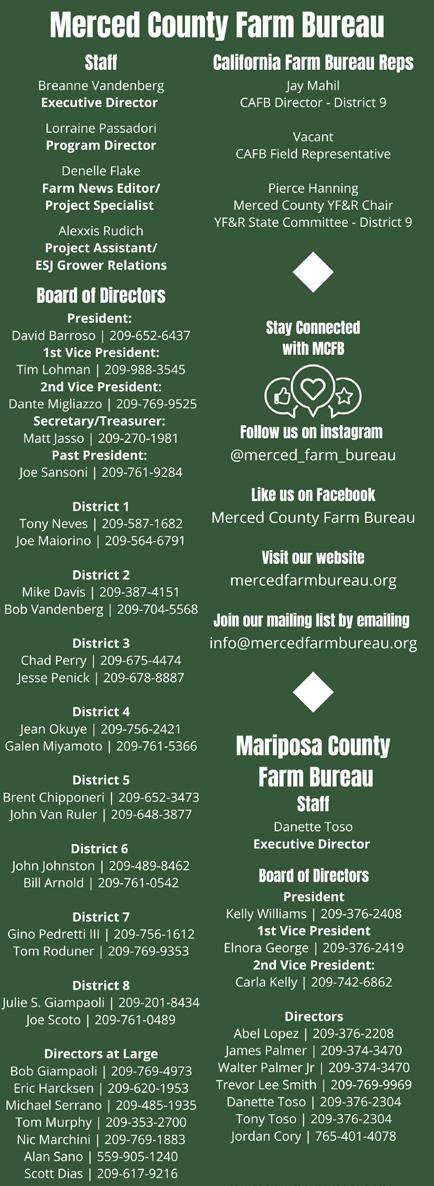
Museum Educates Public About How Farmers Work Hard to Use Less Water
Cultivate California’s exhibits tell the story at Sacramento’s Museum of Science and Curiosity
By: Farm Credit Alliance
Since Sacramento’s acclaimed Museum of Science and Curiosity (MOSAC) opened in November 2021, more than 331,000 visitors have toured the facility, which features dozens of interactive exhibits on topics such as health care, nature, space exploration and water.
A popular MOSAC section is the Water Challenge Exhibit, which includes three interactive displays sponsored by Cultivate California and its nonprofit parent organization the California Farm Water Coalition that illustrate how farmers are working hard to use less water.
Two sisters who recently visited MOSAC said they enjoyed the exhibits and the older one said she’d learned something as well.
“I learned that water is very important and that we need water to grow food for people and to feed the animals we’re going to eat,” said 9-year-old Lyla Frith. Her sister, Kaylyn, 7, enjoyed the exhibits on her own level, saying, “I liked it a lot. The games were fun.”
Both girls worked hard on the interactive exhibits to properly irrigate the fields without running out of water and to create their menus for the day, learning how much water was needed to grow the foods and how much nutritional value they contained in the process. In both cases, the game suggested they eat more vegetables.
Making science fun is one of the ways Cultivate California strives to educate Californians about the vital link between farms and ranches and their water supplies, and how the ag community is working hard to grow even more food and fiber while using less water, said Farm Water Coalition Executive Director Mike Wade.
“Our water exhibits bring home the fact that water is essential to grow our food and that California farmers are leading the world in conserving it,” Wade said. “It’s important that everyone know that farmers are using water in an efficient manner and that as consumers, we all depend on farmers.”
Jacob DeBoer, with American AgCredit, said creating innovative ways to educate Californians about the importance of California agriculture is why Farm Credit organizations serving the state’s farmers and ranchers are contributing $100,000 to Cultivate California this year.
“Firmly rooted in American AgCredit’s core values is an unwavering commitment to the communities where we work and live,” DeBoer said. “The MOSAC exhibit does such a great job of educating California consumers on how vital water is in growing the food that feeds our families, and how farmers are always aiming to optimize their water usage to ensure they’re being good stewards of our land.”
Kevin Ralph, AgWest
Farm Credit’s California President, agreed.
“Providing accurate information about California agriculture to our state’s mainly urban population is critically important, and every year Cultivate California finds new creative ways to reach people online and get them to engage with the content,” Ralph said. “Farm Credit looks forward to continuing to help them spread the good news about the state’s farms and ranches.”
Ag West Farm Credit, American AgCredit, and CoBank, Colusa Glenn Farm Credit, Fresno Madera Farm Credit, Golden State Farm Credit and Yosemite Farm Credit have sponsored Cultivate California since its inception in 2015. The three organizations are part of the nationwide Farm Credit System, the largest provider of credit to U.S. agriculture.
Of course, the MOSAC exhibit is just one part of Cultivate California’s toolkit. The bigger part of their outreach is via paid advertising on social media channels.
“There are two facets to what we do. The first is to get their attention, and that’s with imagery and food facts, recipes, information about which regions grow
different products, and what’s in season,” Wade said.
“That helps get their attention, then we tailor the rest of the message about the importance of water to bring food to consumers and the value of California production over imports where we have less control over how commodities are grown. We get their attention and then deliver the message about why California is such an important ag state.”
He said the digital campaign reached about 10 million people in 2023 and resulted in over 165,000 people engaging with the material through likes, comments and shares. To reach an even broader audience, the campaign is branching out into social media platforms that cater to younger audiences.
“None of this would be possible without the ongoing support of the Farm Credit system,” Wade said. “Farm Credit is among our most generous supporters, allowing us to drive our messaging the way we intended.”

Sisters Kaylyn (left) and Lyla Frith work hard to create their menus for the day at Sacramento’s Museum of Science and Curiosity, learning the amount of water needed to grow the day’s food.
Red Leaf Blotch: A New Disease of Almond in California
Florent Trouillas, Associate Professor of Cooperative Extension, Department of Plant Pathology, University of California, Davis Alejandro HernandezRosas, Graduate student, Department of Plant Pathology, University of California, Davis Rosa Frias, Laboratory Assistant, Department of Plant Pathology, University of California, Davis Tawanda Maguvu, Postdoctoral Researcher, Department of Plant Pathology, University of California, Davis Cameron Zuber, Orchard Crops Advisor, University of California Cooperative Extension, Merced and Madera Counties and Phoebe Gordon, Orchard Systems Advisor, University of California Cooperative Extension, Madera and Merced Counties
Background
Red leaf blotch (RLB) caused by the fungal pathogen Polystigma amygdalinum is one of the most important leaf diseases currently affecting almond trees in the Mediterranean basin, particularly in Spain, and regions of the Middle East. In late May 2024, unusual symptoms on leaves, including yellow spots and orange to dark redbrown blotches, were detected in an almond orchard (Nonpareil, Monterey and Fritz) on the border of Merced and Madera counties. The disease has since been observed in Madera, Merced, San Joaquin, and Stanislaus Counties, suggesting that the disease is
somewhat widespread in the Northern San Joaquin Valley. Following field sampling as well as morphological and DNA/ PCR analyses, our laboratory confirmed the detection of P. amygdalinum from symptomatic leaves. This is the first detection of P. amygdalinum from California almond, although a formal pest confirmation by the California Department of Food and Agriculture (CDFA) is pending. Growers and PCAs should be on the lookout for RLB as it is new to California and a serious
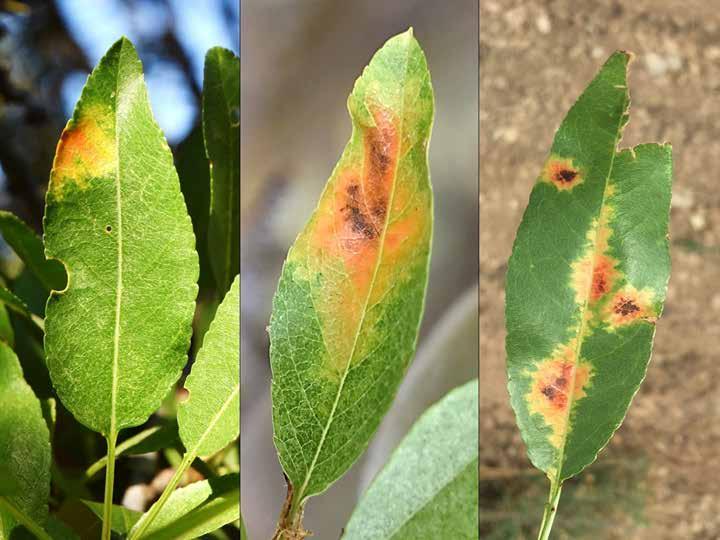
disease of almond.
Disease symptoms and biology
Symptoms of RLB initiate as small, pale yellowish spots or blotches that affect both
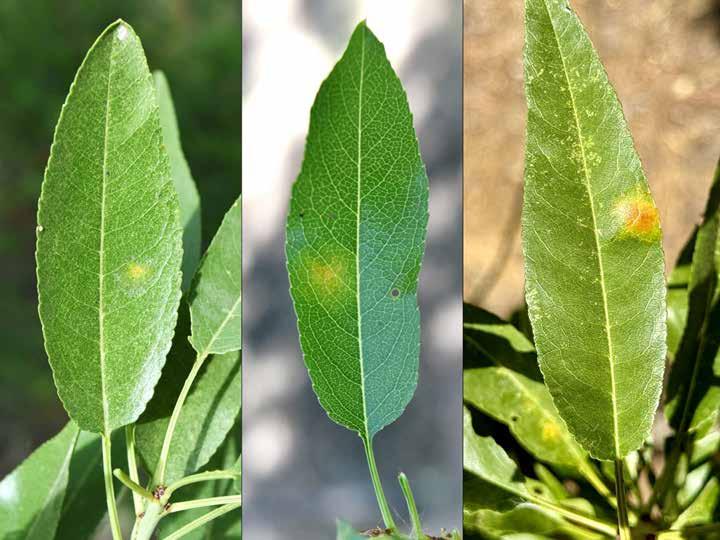
sides of the leaves (Fig. 1). As the disease progresses, the blotches grow larger (1 to 2 cm) and turn yelloworange with a reddishbrown center (Fig. 2). At advanced stages of disease development, leaves become necrotic, curl, and drop prematurely. Mainly the leaves are affected, and premature defoliation of trees can occur, thus decreasing the photosynthetic capacity of the tree during the current and following growing season, leading to a general decrease in yield.
The disease is monocyclic, with only one primary infection cycle. The primary inoculum are ascospores that form in perithecia (sexual fruiting bodies) on fallen
See 'Red Leaf Blotch' Page 7
Figure 1. Early symptoms of red leaf blotch include small, pale yellowish spots or blotches that affect both sides of the leaves. (Picture credits: Alejandro Hernandez and Florent Trouillas).
Figure 2. Advanced symptoms of red leaf blotch include larger, yellow-orange blotches (1 to 2 cm) that turn reddish-brown in their center. (Picture credits: Alejandro Hernandez and Florent Trouillas).
Red Leaf Blotch
continued from page 6
infected leaves from the previous growing season. Infection occurs after petal fall when young leaves emerge and spring rains occur. Rain is essential for the release and dispersal of ascospores from perithecia. The disease may not be noticed before late April to mid-May as infection remains latent for approximately 35 to 40 days. Infected leaves develop small yellow blotches that expand and become orangish to reddishbrown, with variable shapes and sizes, as the fungus colonizes more leaf tissue. During spring/summer leaves contain the pycnidia (asexual fruiting bodies) of the fungus, which produce filiform conidia. These asexual spores do not cause new infection on leaves. Infection of leaves decrease drastically after June and with high summer temperatures. Rain combined with mild temperatures in spring and early summer generally lead to higher disease incidence.
Disease Management
Research and experience in Spain where RLB is more common have shown that one preventive fungicide application at petal fall and two additional applications at two and five weeks after petal fall if rains persist are effective at controlling the disease (this exact timing is not critical but depends on the occurrence of rainfall). This means that fungicide applications and timings to control other common diseases of almond in California such as shot hole or anthracnose will likely also control this pathogen. Researchers in Spain also
have shown that FRAC groups 7, 11, M3, M4 and some FRAC3 chemistries are most effective. Cultural practices, focused on eliminating the primary inoculum of infected fallen leaves, also can help mitigate the disease. These consist of removing leaf litter or applying urea to accelerate its decomposition. However, such strategies are only effective when applied over a wide area. Fungicides applied during bloom and after symptoms are visible are not effective.
If you suspect that you have this new disease in your almond orchard, please contact your local UC Cooperative Extension farm advisor.
Disclaimer: Mentioning
of any active ingredients or products is not an endorsement or recommendation. All chemicals must be applied following the chemical label, local and federal regulations. Please check with your pest control adviser to confirm rates and site-specific restrictions. The authors are not liable for any damage from use or misuse. This article was first published on San Joaquin Valley Trees and Vines website.
References
López-Moral, A., AgustíBrisach, C., Ruiz-Prados, M.D., Lovera, M., Luque, F., Arquero, O. and Trapero, A., 2023. Biological and urea treatments reduce the primary inoculum of red leaf blotch of
almond caused by Polystigma amygdalinum. Plant Disease, 107(7), pp.2088-2095.
Torguet, L. 2022. El inicio del fin de la mancha ocre (Polystigma amygdalinum) como enfermedad clave del almendro. XIV Jornada Del Almendro. Les Borges Blanques, 22 septiembre 2022. IRTA.
Torguet, L., Maldonado, M., Miarnau, X. 2019. Importancia y control de las enfermedades en el cultivo del almendro. Agricultura 1026: 72-77.
Torguet, L., Zazurca, L., Martinez, G., Pons-Solé, G., Luque, J., Miarnau, X. 2022. Evaluation of fungicides and application strategies for the management of the red leaf blotch disease of almond. Horticulture 8, 50.
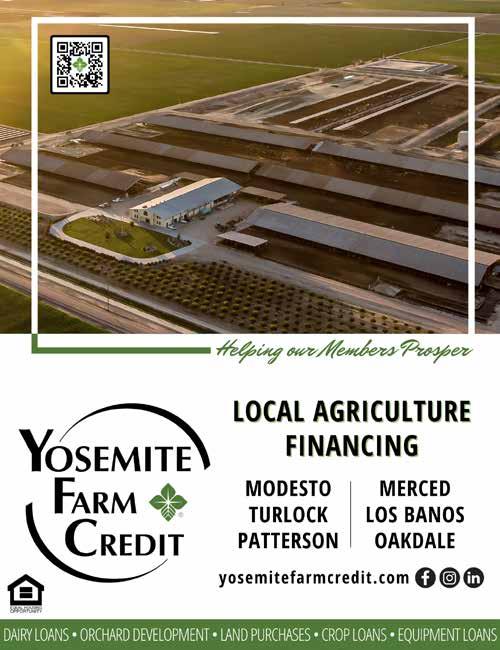


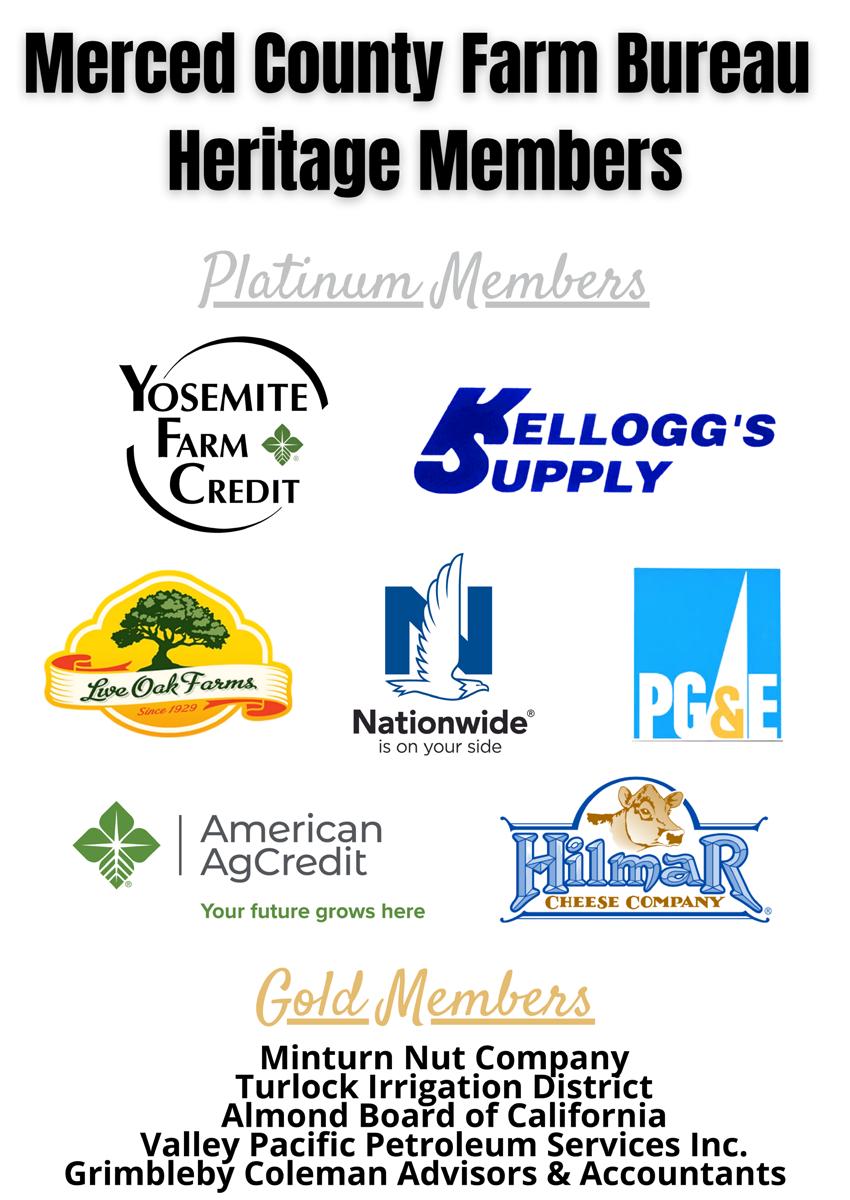
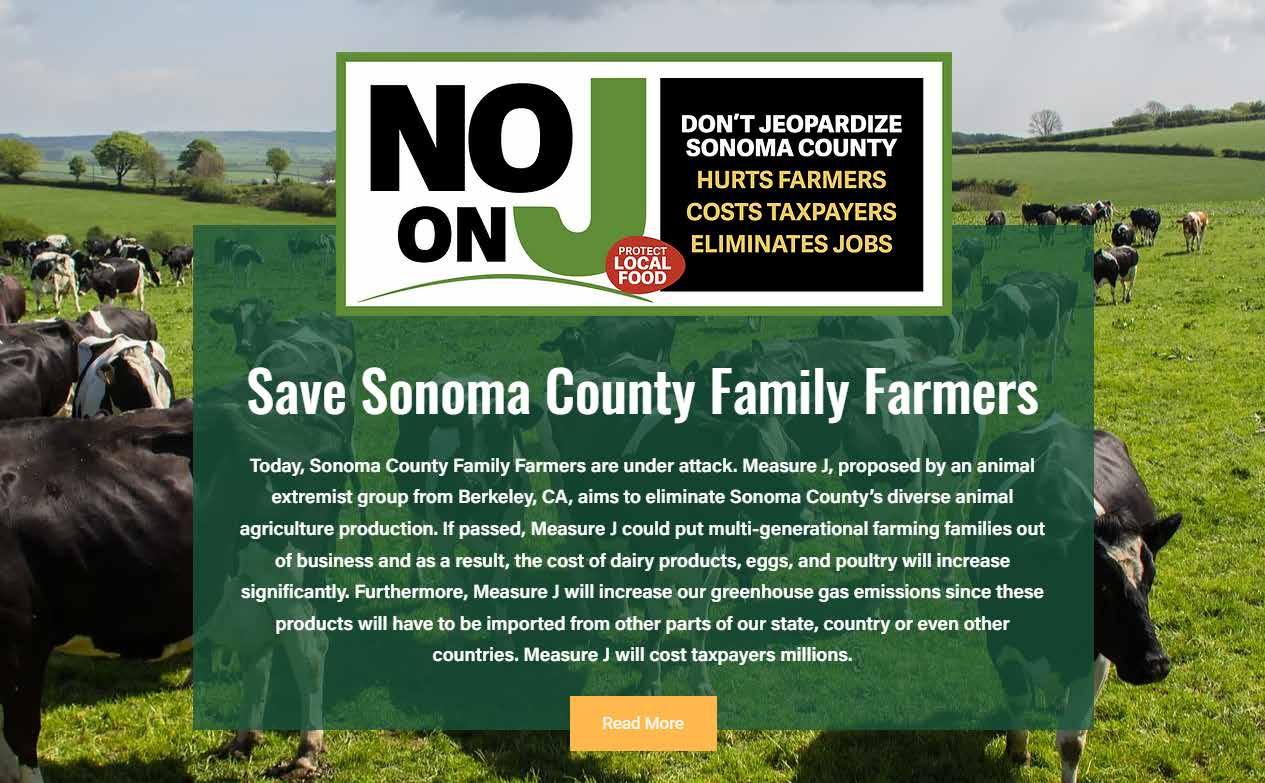

Your Dollars at Work Nutrition Research


The Almond Board’s Nutrition Research Committee was founded in 1995 and has funded over 130 projects researching areas such as heart health, weight management, gut health, cognition, skin kkkkkkkkkkk and othe of global public health concern This commitment has led to a better understanding of the health benefits of in g almonds in a healthy diet
ABC-Funded Nutrition Research Examples:
SKIN HEALTH
How almonds might impact wrinkles and skin pigmentation in postmenopausal women and help support UVB protection. DIABETES
Randomized controlled studies are examining how the consumption of almonds impacts blood sugar levels.





ATTENTION
Farmers and Farm Employees who need to renew their DL-267 Endorsement or acquire their initial endorsement.

The Agricultural Hazardous Materials Transportation Program is being offered by the Farm Bureau and Nationwide Insurance. This class is for persons 21 years or older and have a current California Class C drivers license.
Due to new requirements, once a person completes the course, they must:
• Submit completed training record along with a completed CHP application
• Await paperwork return from CHP
• Pay any applicable DMV fees
• With returned CHP paperwork apply for DL-267 certificate from the DMV
Cal/OSHA Board Adopts Workplace Standard for Indoor Heat
By: Insurance Journal
ACalifornia workplace safety oversight board adopted a new standard for indoor workplaces to enact safety measures when the temperature reaches 87°F.
The Occupational Safety and Health Standards Board approved an indoor heat standard that requires indoor workplaces to be cooled below 87°F if feasible when employees are present, and below 82°F if feasible in
places where workers wear protective clothing that restricts heat removal or work in high radiant heat areas.
Local and state correctional facilities as well as emergency operations directly involved in the protection of life or property are exempted from the proposed regulation. Cal/ OSHA is in the process of developing an industryspecific regulation for local and state correctional facilities.
Cal/OSHA’s heat illness
prevention regulation applies to most indoor workplaces, such as restaurants, warehouses and manufacturing facilities. When the indoor temperature reaches 87°F, employers are required to take steps to protect workers from heat illness. Requirements include providing water, rest, cooldown areas, methods for cooling down the work areas under certain conditions and training.
Employers may be covered under both the indoor and
outdoor regulations if they have both indoor and outdoor workplaces.
The board is a sevenmember body appointed by the governor, and it is a standards-setting agency within the Cal/OSHA program.
The Office of Administrative Law has 30 working days to review and approve or deny the proposal. The board requested that the regulation take effect immediately after OAL approval.

CAFB
continued from page 1
markets and needs year to year.
I graduated from college with a degree in agriculture. I then went to work for Chico State. While I was there, I went back to school, got my master's degree in ag policy. As we were trying to expand the farm operation and start a family, there was a need for a lot more flexibility. So I, with a partner, started CalAg Jobs. For over a decade now CalAg Jobs has worked to try to connect employers with candidates in California agriculture.
So that's been my Farm Bureau path. It really started because I saw the impact that Farm Bureau could have and the amazing work that could be done when we work together across commodities and across regions, etc.
How have the first months of your CAFB presidency gone, and what do you think makes you stand out from previous presidents?
I think that each president of the CAFB has brought some unique perspectives to the table and different styles. In the CAFB, we do have term limits for our presidents. Not all states have that. I think it's neat to find some things that were great from a particular president, and then keep adapting things over time.
… In December of 2023 our delegates said, We really want to start thinking about our structure at CAFB and if we have a structure that makes the most sense. Farm Bureau's 105-plus years old now, so things have to adapt over time. This is a concept that our delegates passed unanimously.
… [A] very big part of my first six months [has been] the process of going through and hiring and now recently being able to announce our firstever chief operating officer. We are really excited to have Dan Durheim on board. He brings with him almost 20 years of experience with the American Farm Bureau. He is not a lobbyist .… We have a great advocacy department … but we also needed to have someone with an operations and a marketing background, and Dan brings that as well as his experiences growing up as a Minnesota farm kid.
Now we get to have some more time for activities in the next six months and continue to work with our counties and our members … on finding solutions to our California farmer challenges. We're wrapping up with the next legislative session. Is there anything that you are going to keep a close eye on?
We’re keeping a watchful eye in general. We do have our CAFB sponsored bill that is looking at the health impacts of wildfires, trying to collect a lot more data. We're anticipating that the data will frankly show—as most of us in California know—that smoke does have negative health impacts for our children, for our schools, for our community. … By recognizing that, we're hoping to help justify the need for continued forest management and managing fuels in areas where wildfires have been so prevalent.
The budget situation in California is something we will keep monitoring because there are a lot of programs that we're concerned about what the funding is going to look like, as well as some other ways that the state will
look to fill some of these budget gaps.
Talk a little bit about women in leadership roles—particularly in the agricultural industry—and what your advocacy looks like there.
There are seven state farm bureau presidents who are women. … I am the first in California. … Well over 30% of farms are owned and operated by women, so I think it's not surprising that we've seen … more female faces emerging and continue to be involved as leaders in their own businesses and on their own farms. I am very thankful for all of the women who got involved when it was less easy to get involved.
One thing that's been very important to me is encouraging people to get involved and to stay involved. We know that people have busy lives and sometimes the work that we do can be overwhelming. I want to really be sure that we don't have anyone saying, “Oh, I can't get involved because it's really a group that's not for me. It's a group where I don't fit those demographics.” … [I]t's important for people to know that Farm Bureau is about our advocacy as farmers and ranchers. If you have the interest and passion in that space, we'd love to have you engaged. Maybe that's working in our ag education programs at the county level or state level, or maybe that's serving on one of our statewide committees.
Are there any messages you have for the lawmakers or their staff who read this?
It's been important this year that we have talked to our elected officials and our regulatory staff about the
challenges we're facing in this farm economy and the pressures on our California growers. As we see increased regulatory pressures, it makes it harder and harder, particularly for our small and disadvantaged farmers. From the outside they think, ‘Well, you know … it’s a small amount. It's just a few pennies per unit.” But it really adds up.
There was a regulatorycost study done by Cal Poly, San Luis Obispo. I just got word that they are looking to repeat that study for a third time … I will be very fascinated to see what the results are. In a 10-year time span, regulatory costs had increased for a midsize grower on the Central Coast by 795%. Our growers are having that eight-fold increase, basically, when they are competing against products from other states and other countries that do not have that burden and that legitimately can produce cheaper.
It becomes very frustrating to be in a state that seems to want local farms and small farms and making sure we have local food in the communities, but at the same time the regulatory burden placed on us makes it so hard to do that.
Sacramento politics are often challenging and contentious. What’s it like stepping into an arena like this?
I don't think it was a surprise. … For me, the motivation to keep at it and keep pushing forward is really how important it is for the next generation. So yes, it can be very frustrating. Yes, we have a real uphill
See 'CAFB' Page 15
CAFB
continued from page 14
battle, but we do have the opportunity to make a difference. I very much want to make sure that my son and his peers, your readers' grandchildren or nieces or nephews or whoever's just going to buy their farm … to make sure that they get to have that opportunity here in California. Frankly our state needs it, too.
We're going to have to continue fighting and telling our story, and the work that we do just becomes more important than ever before.
Is there anything else you’d like people to know?
I think it’s helpful to share with people the importance of working together. These are really trying times in agriculture [and] we recognize that it's reminding people of some rough decades that we had before. There aren't a whole lot of sectors of ag that are doing well—it’s why so many people have diversified over time.
But when things are challenging is really when I would argue we need Farm Bureau more than ever before. When things are hard is when we have to make sure we have our voice at the table. … Whether it's about our legislative issues or dealing with some of the regulatory challenges, it's having our representatives at the water meetings and the SGMA meetings and being engaged … on trade issues and on and on and with Department of Pesticide Regulation.
But while it is challenging, it's so critically important to stay engaged and stay a part of us. So if people have not gotten involved in Farm
Bureau before, I'd really encourage them. Now is a great time to get involved.

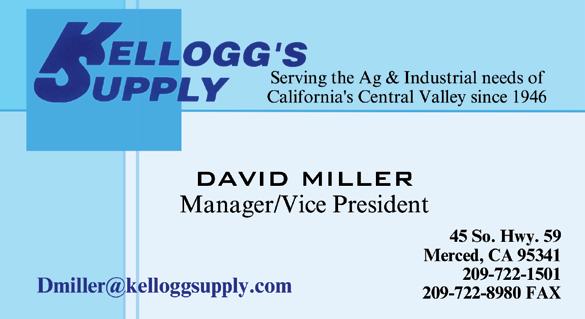

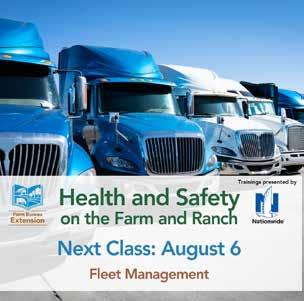
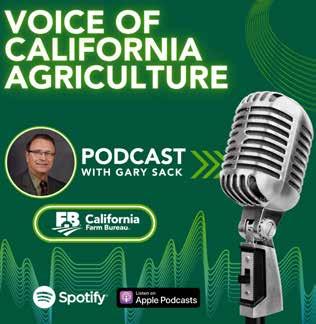

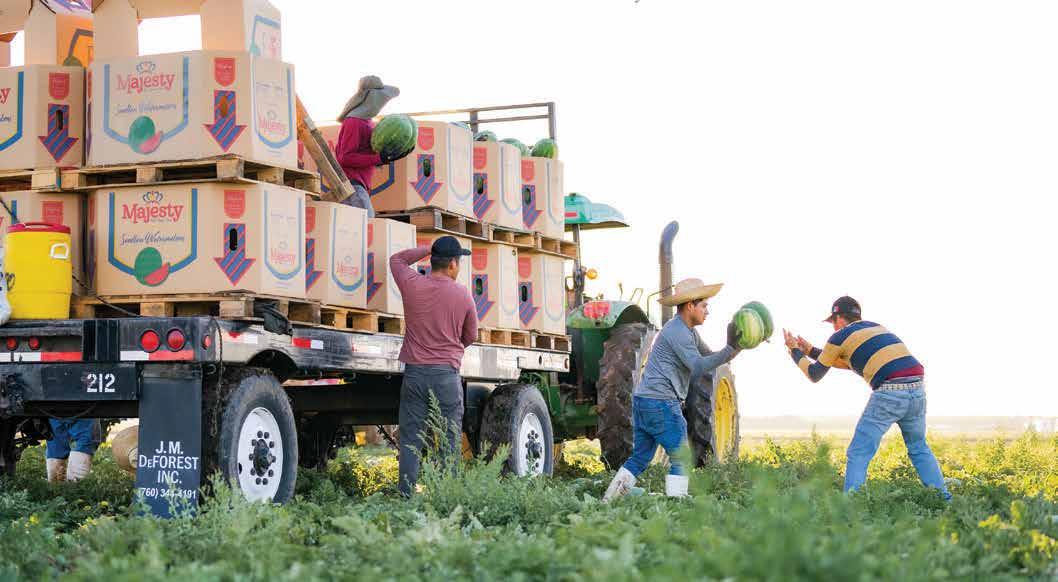
2023 1st place winner

Prizes
1st place $1,000
2nd place $500
Open now through September 22 ENTER YOUR PHOTO!
Submit photos of fresh food, rural scenery, animals, crops, harvests, life, work, family or any inspiring photo captured on the farm or ranch.
Enter up to fi ve high-resolution photos for the general contest and one photo for the People’s Choice category at cfbf.com/photocontest.
3rd place $250
People’s Choice $100
Honorable Mentions $50 (six winners)
Budding Artists (ages 13 & younger)
1st place $250 2nd place $100
Voting for the People’s Choice category will be open from Sept. 24–30.
The contest is open to amateur photographers who are Farm Bureau members. Participants who are not Farm Bureau members can visit cfbf.com/join to learn about becoming a member. Go to cfbf.com/photocontest for contest rules.
Cayden Pricolo, Merced County
Beginning Farmers & Ranchers Mentorship Program
Enroll in a New Program Aimed at Preserving California’s Agricultural Heritage.
Beginning farmers and ranchers in California face many challenges in sustaining their agricultural operations. This program provides no-cost mentoring services from experienced farmers and ranchers to facilitate knowledge transfer.
Who can become a mentor?
Farmers (including specialty crop growers) and ranchers with more than 10 years of experience operating a production agriculture business in California can become mentors.
Benefits of becoming a mentor:
• Receive incentive pay ($50/hr) for up to six hours of time invested in mentoring a beginning farmer and/or rancher.
Who can become a mentee?
• Share knowledge, skills, and experience to help guide the long-term success of a beginning farmer and/or rancher in California.
Farmers (including specialty crop growers) and ranchers with one to 10 years of experience operating a production agriculture business in California can become mentees.
Benefits of becoming a mentee:
• Learn from experienced farmers and ranchers through six hours of mentoring.
• Attend biannual workshops alongside subject matter experts and peers.
• Enjoy annual subscriptions to the Ag Alert® weekly newspaper and Farm Bureau Extension classes.

• Work towards self-declared goals such as adopting new management practices, scaling production and distribution, learning established and emerging marketplaces, improving business accounting and finance fundamentals, and more.
To enroll as a mentor or mentee, complete an online application at cfbf.com/EOR. Information from the online application will be used to match mentors and mentees.
Funding for this Project was made possible by a grant/cooperative agreement from the U.S. Department of Agriculture (USDA) Agricultural Marketing Service and National Institute of Food and Agriculture. Its contents are solely the responsibility of the authors and do not necessarily represent the official views of the USDA.

California’s Ag Leaders Warn of Animal Activists’ Plans to Harm US Livestock Industry
By: Sabrina Halvorson, Hoosier Ag Today
Shutting down our hog, cattle, and poultry farms is the overall goal of animal rights activists. That’s why ag leaders in California are warning farmers across the rest of the U.S how activists are using their state to impose laws to destroy the country’s livestock industry.
“For them, this is a steppingstone—that they are seeking out to throw something against the wall and see what sticks. Because if they can make it happen here, it’s going to take off,” says Dayna Ghirardelli, Sonoma County, California, Farm Bureau Executive Director.
She’s talking about animal activists who have selected Sonoma County as their target for the state’s next anti-animal ag law. The group says it’s targeting big factory farms, but Ghirardelli says that’s simply not the case.
“The majority are family farms. There may be one group of farms that might fall under our corporate structure, but for the most part they are locally owned or locally operated,” Ghirardelli said. “Absolutely our food shed here in Sonoma County is very much family farming.”
Farm Bureau and other ag organizations are pulling together to educate voters about their local family farms and what the measure would do to them, but Ghirardelli says it’s a costly campaign
and they could use some help.
“Support us in whatever way you can,” she said.
“Not just by endorsing, but if there’s any financial
contributions that can be offered because we know that this is going to be in at least $1.65 million effort to combat as a fully waged campaign.”
You can get more information on the Sonoma County Family Farmers Alliance website: www. noonmeasurej.com.








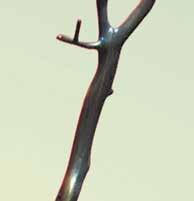




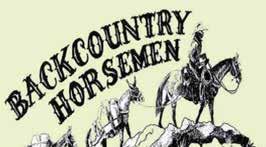








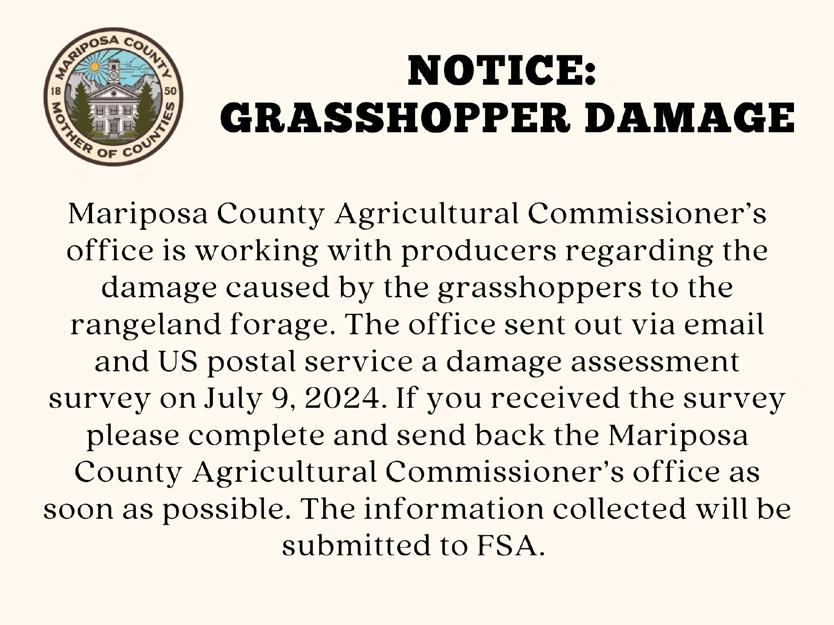


By the Dawn’s Early Light
Francis Scott Key’s poem that later became our National Anthem was ringing through the county of Mariposa on Independence Day. Every year children and adults look forward to celebrating the birth of our nation. Yes, the children are most interested in watching fireworks, (where permitted) and enjoying ice cold treats. The elders are brimming with pride to be living in a free Republic where any dream can become a reality, the sky is the limit! This year, the 4th was a lot hotter than usual in Mariposa, and the heat wasn’t only weather related.
The French Fire began just after 6 p.m. on Thursday, July 4, in the area of French Camp Road and Highway 49 North. Due to high temperatures, low humidity and gusty winds, the fire began spreading quickly, burning through dry grass and other fuels.
Once the fire “spotted” across Highway 140 east of Mariposa, Deputy Cal fFire Chief Steve Ward said it became “two fires at once.” The firefighters knew that the entire town of Mariposa was in eminent danger of being wiped out, and it became an extremely threatening situation. John C. Freemont Hospital became threatened by the flames, and evacuations were considered. It was decided that with
the large parking lots and defensible space around the hospital, sheltering in place was a better option.
Mariposa County High School was also in the path of the fire, and by the grace of God, and our dedicated first responders the high school was spared with only a couple of outbuildings being lost. Another huge factor in stopping the progress of the fire overnight was the use of helicopters which can drop water at night. This is a relatively new resource for CAL FIRE and it was utilized perfectly in this fire.
As part of that entire process, sections of Mariposa had to be evacuated, a job that the sheriff’s office is responsible for. Sheriff Briese said he feels the evacuations “went smoothly” and felt the
repopulations also were “done correctly.” Briese credited his entire department for the quick response to the French Fire, from dispatchers to animal control to the many search and rescue volunteers, and more.
In total, over 900 acres were burned, three residential structures and one commercial structure were destroyed in the fire, said Ward. There were seven outbuildings damaged in the fire. The areas were scattered, he said, including Grosjean/ Alta Vista, Campbell Way and Highway 140. In this particular fire, there were no civilian injuries and Ward said there were four “minor” injuries to firefighters. By the dawn’s early light of July 5th, we were still here, Mariposa Strong and getting stronger.
Please heed the warnings from Cal Fire and clear a defensible space around your home and outbuildings for at least 100 feet. This important task done before vegetation dries out can save your home, property and life. We remain Mariposa Strong and as always, I encourage farmers, ranchers and conservators to invite friends, neighbors and family members to join the collective voice of the Farm Bureau. Together, we can make our organization and the Mariposa community stronger than ever, one member at a time.
To donate to the victims of the French Fire, please email Mariposa County Disaster Relief Services at MariposaRelief@gmail.com for more information.

Photo of French Fire taken by Debbie Peters
